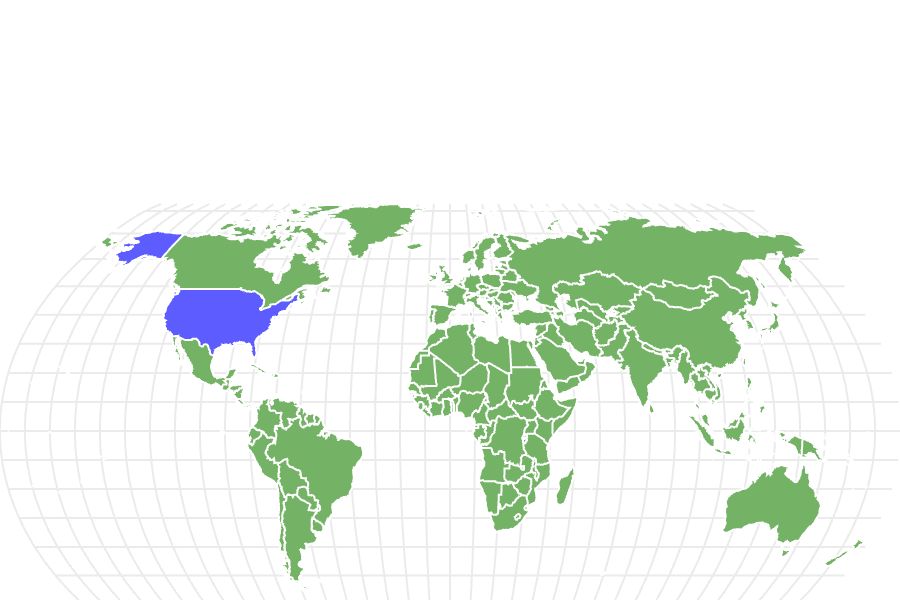Rough Green Snake
Opheodrys aestivus
Rough green snakes are great pet snakes because they're low-maintenance.
Advertisement
Rough Green Snake Scientific Classification
- Kingdom
- Animalia
- Phylum
- Chordata
- Class
- Reptilia
- Order
- Squamata
- Family
- Colubridae
- Genus
- Opheodrys
- Scientific Name
- Opheodrys aestivus
Read our Complete Guide to Classification of Animals.
Rough Green Snake Conservation Status
Rough Green Snake Facts
- Prey
- Insects, snails, spiders, and small frogs
- Fun Fact
- Rough green snakes are great pet snakes because they're low-maintenance.
- Other Name(s)
- Grass snake, green grass snake
- Litter Size
- 3-12 eggs
View all of the Rough Green Snake images!
The rough green snake loves to climb trees in pursuit of prey.
The non-venomous rough green snake is quite a remarkable sight. Identification is quite easy because their bright emerald, green scales are unmistakable. Still, they blend in with the lush plant life around them in their preferred habitats, which include wetlands, uplands, forests, and other areas that are abundant with insects. They are quite smooth and stealthy predators, stalking their prey until they can swallow them whole.
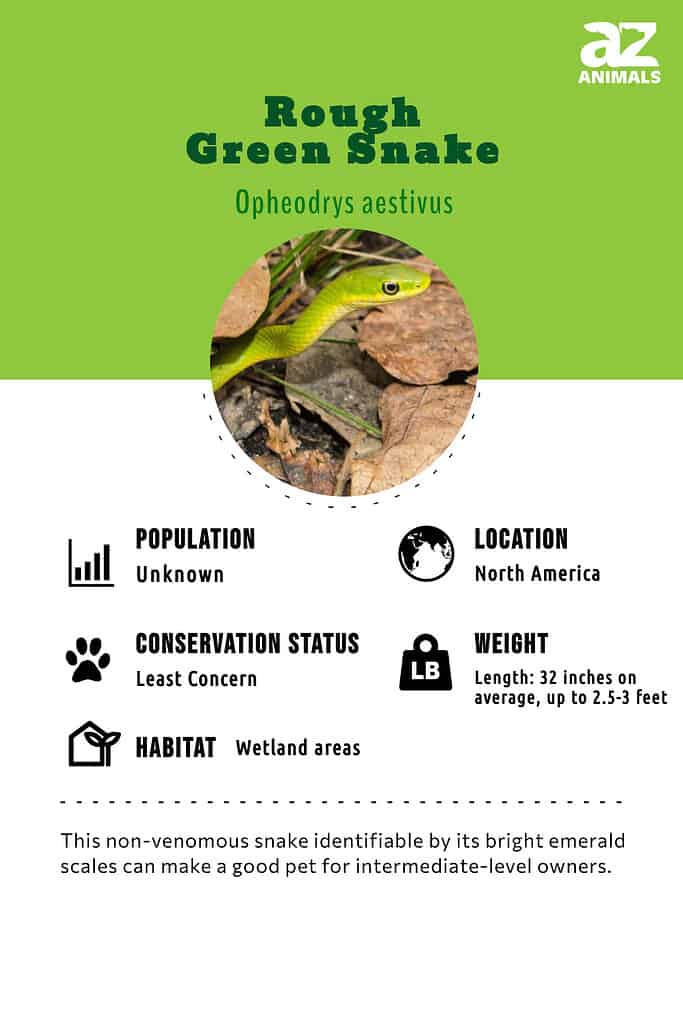
5 Incredible Rough Green Snake Facts!
Here are a few facts you may not know about the rough green snake:
- The snake’s size typically is about 32 inches but can range from 2.5 to 3 feet long.
- Even though this snake can be hard to find, they have multiple natural predators, including birds, cats, spiders, and larger snakes. They don’t really have any defenses beyond camouflage.
- Despite their lack of legs, the rough green snake loves to climb trees in pursuit of prey.
- They only hunt during the daytime, using their flickering tongue and incredible eyesight to seek out food.
- When kept as a pet, this snake does not like to be handled during its care as it causes them a great deal of stress.
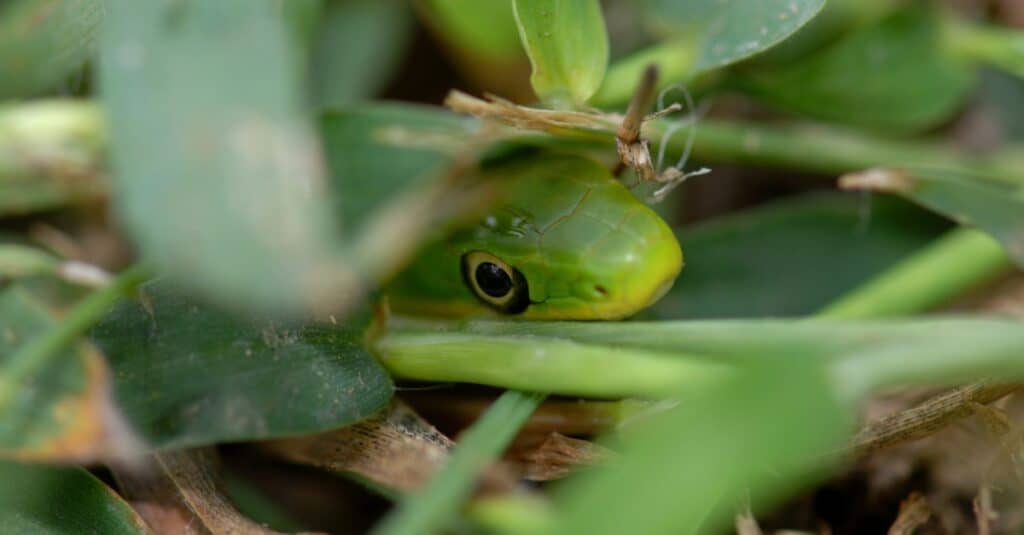
Due to their coloring, rough green snakes can blend in easily with plant life, which helps them hide from predators.
©iStock.com/Shoemcfly
Where to Find Rough Green Snakes
North America is the main location you can find these snakes, specifically in wetlands. Their most common location is in the eastern and southeastern region of the United States, found in abundance from New Jersey to Florida, though they can be found as far west as Kansas and Texas. Though it isn’t common, they may reach New Mexico.
Regardless of the specific location in the country, rough green snakes prefer to live in wetland areas, which is why they aren’t usually found in the arid climates of Arizona and Colorado. They’ll also look for ponds and streams that allow them to swim and look for prey. If you look up, you might even see them hanging in trees.
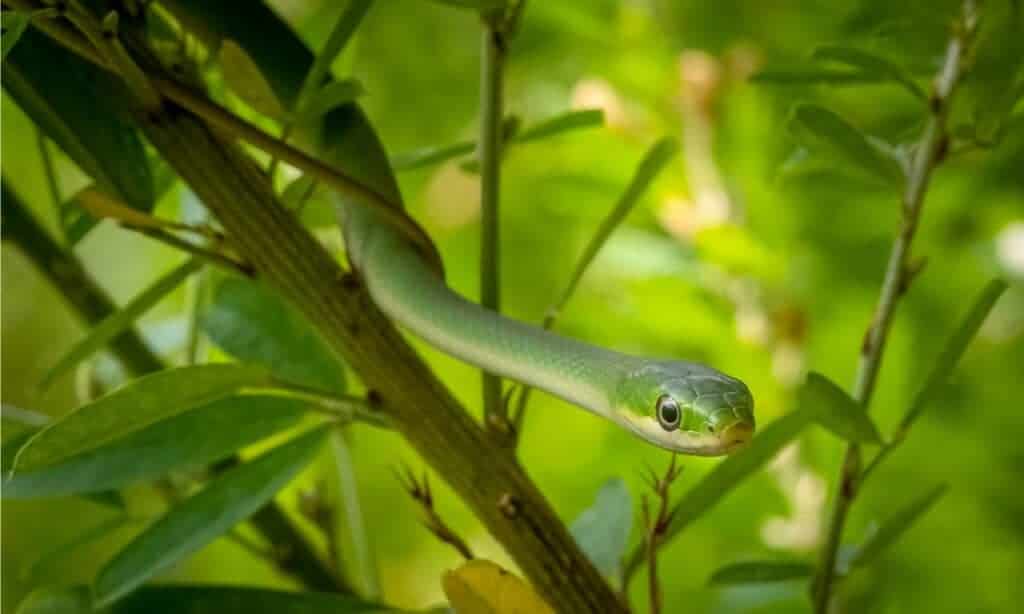
Rough green snakes prefer to live in wetland areas and can be found in trees hunting prey.
©samray/Shutterstock.com
Scientific Name
The rough green snake, which is sometimes referred to as the grass snake or the green grass snake, has the scientific name Opheodrys aestivus. Opheodrys comes from the Greek words ophios (“snake”) and drys (“tree”), aestivus is the Latin word for “summer.” It makes sense that the snake is more abundant during warmer months.
Two Types of Rough Green Snake
While some herpetologists recognize subspecies of the rough green snake, others do not. The two that could be considered subspecies are:
- Northern rough green snake (Opheodrys aestivus aestivus): These snakes’ range includes the southeastern regions of the U.S. and northeastern Mexico. Their second midbody row of dorsal scales is not typically keeled.
- Florida rough green snake (Opheodrys aestivus carinatus): This subspecies is present in Florida’s central and southern peninsula as well as in the Florida Keys. Its second midbody row of dorsal scales is normally keeled. It is a little bigger than the northern rough green snake.
Rough green snakes are sometimes referred to as grass snakes or green grass snakes — which are also used to describe smooth green snakes (Opheodrys vernalis). It could be easy to confuse the two, but while they are both similar colors, the smooth green snake is a different species that is smaller and has smooth scales.

Smooth green snakes are not the same species as rough green snakes and differ in size and scale type.
©iStock.com/tamers1
Evolution and History
The rough green snake belongs to the Colubridae family, which is the biggest snake family with 249 genera. Earliest colubrid species date back to the Oligocene epoch, between 33.9 million to 23 million years ago. Fossil records from different colubrids have been found in the Ringold Formation of Washington’s Adams County.
The rough green snake’s embryos have evolved to be relatively well-developed when laid in comparison to other snake species’ embryos. Due to the shorter incubation time outside of the female snake, there is less time for potential predators to prey on the eggs.
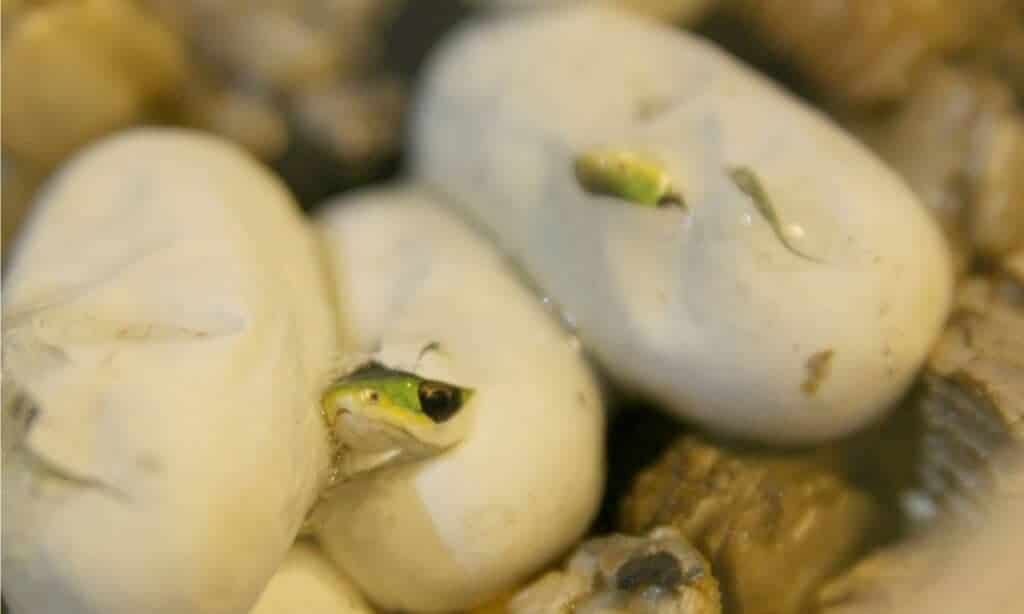
The shorter incubation period for rough green snakes means less time for predators to find and eat the eggs.
©Stuart Hamilton/Shutterstock.com
Population and Conservation Status
Determining the exact population of this snake is incredibly difficult for two reasons — they camouflage well, and few researchers have looked into their numbers before. According to a 1997 report by the scientist Alan J. Redder, there are about 295 snakes per acre in the United States. Considering these high numbers, there are no conservation efforts as they are considered to be Least Concern by the IUCN.
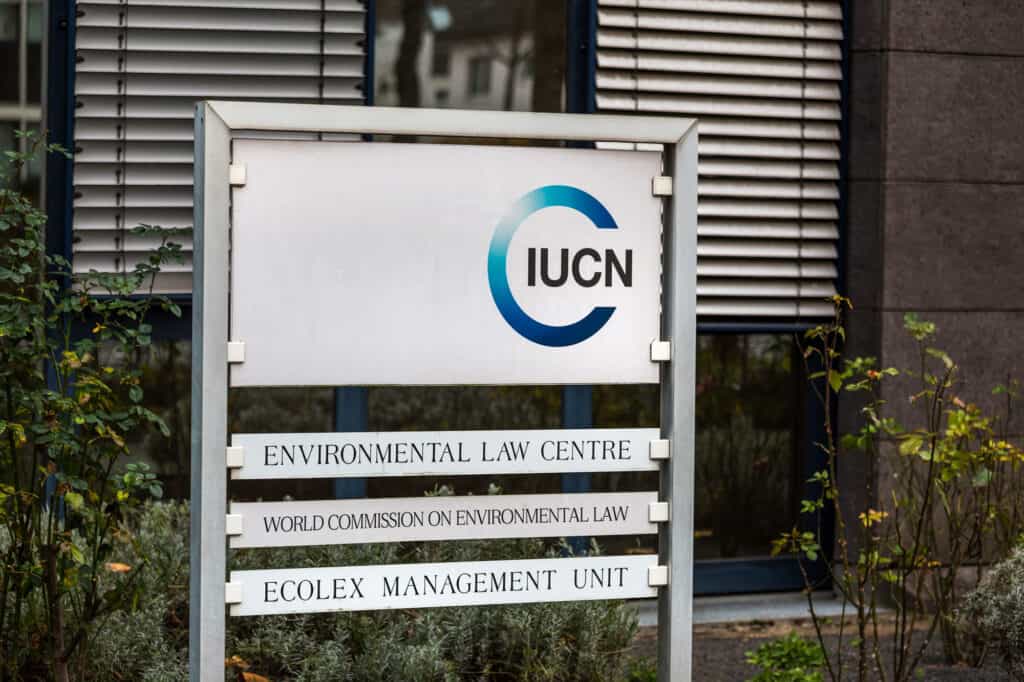
The rough green snake is classed as of Least Concern by the IUCN.
©Tobias Arhelger/Shutterstock.com
Appearance and Description
Part of the appeal of the rough green snake is its beautiful emerald green body, making identification relatively easy in the wild. Their scales often feature lighter yellow along their sides, lightening to almost white on their belly. These colors set it apart from some of the less attractive species, which is why so many people want them as a pet.
Identification of the younger snakes can be determined by the blue dots along their head and the rest of their body, though these colors sometimes show on adults. Their rough-looking skin makes it easy to swim or climb trees. While their head is quite small, their body tapers to a much narrower width down the body. They have large eyes, and they measure approximately 2.5-3 feet in size as adults.
Due to the way that they feed, the diet of this reptile has to be carefully managed. They are unable to safely break apart the exoskeleton of certain insects. Their jaw allows them to swallow their prey whole, so it is safest to consume softer insects.
How to identify a rough green snake:
- Emerald green skin with yellow or white bellies.
- May have blue dots along the head and body.
- Body thins towards the tail.
- Large eyes.
- Small head.
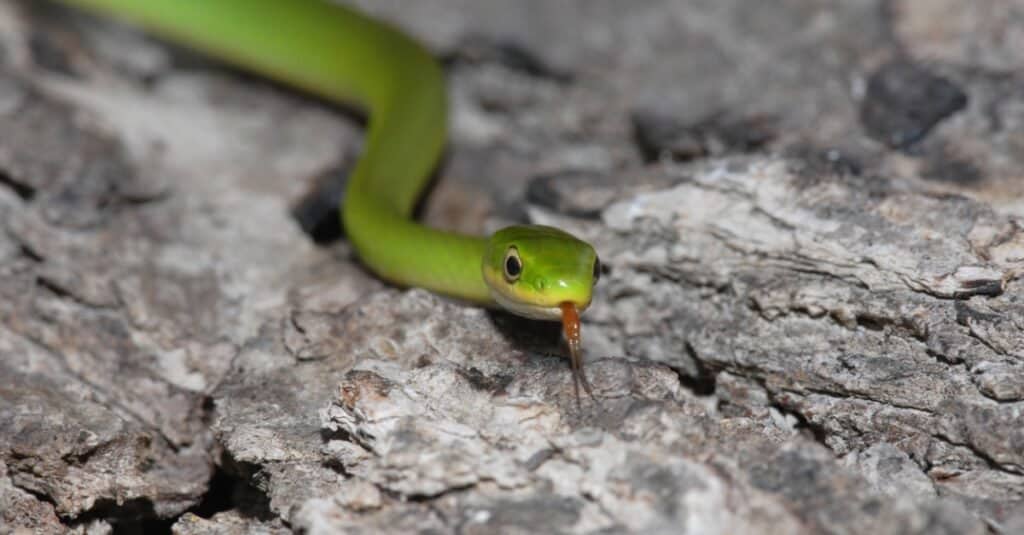
It is easy to identify younger snakes because of the blue dots that are on their head.
©iStock.com/Shoemcfly
Venom: How Dangerous Are They?
Even with the bright colors of the rough green snake, there’s no need to worry — they are non-venomous. Since they aren’t venomous, there is little point to bite. Instead of attempting to bite anyone, they release an odor from their body that is meant to deter any predators. While venomous snakes tend to use their fangs when stressed, it would take a lot more for this reptile to bite anyone
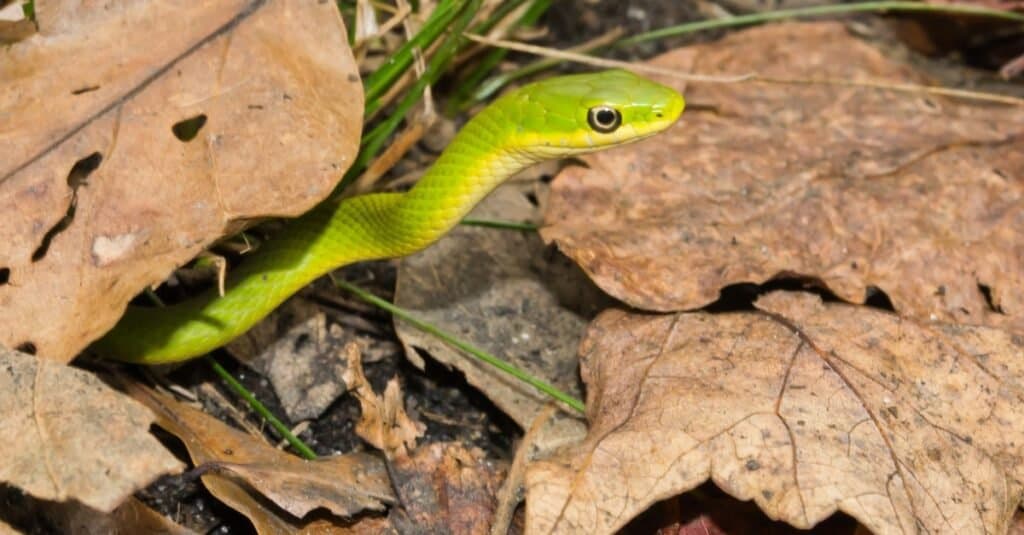
The rough green snake is non-venomous and deters predators by releasing an odor from its body.
©iStock.com/BobMcLeanLLC
Diet
The primary diet of the rough green snake is comprised of insects, especially crickets, caterpillars, and grasshoppers. It is possible to feed them mealworms, wax worms, and similar insects, but this snake might have a tough time getting past the hardness of its exoskeleton.

Rough green snakes mainly eat insects such as crickets.
©Alexander Sviridov/Shutterstock.com
Behavior and Humans
Rough green snakes are harmless since they are non-venomous, and they don’t bite. They aren’t aggressive or highly defensive, and they are often captured in the wild to be sold as pets. In captivity, these snakes on average have a lifespan of five years, and some have been known to reach 15 years old. In the wild, rough green snakes’ average lifespan is also five years, and they can live up to eight years.
Similar Animals
View all 114 animals that start with RRough Green Snake FAQs (Frequently Asked Questions)
Where can I buy a rough green snake?
Rough green snakes are commonly found in pet stores.
What does a rough green snake eat?
The primary diet of this reptile is comprised of insects, especially crickets, caterpillars, and grasshoppers. It is possible to feed them mealworms, wax worms, and similar insects, but this snake might have a tough time getting past the hardness of its exoskeleton.
How do I care for a rough green snake?
This type of snake is not ideal for a novice pet owner. You’ll need at least a 30-gallon tank to use as a habitat for any adult, giving them plenty of space to move. If you choose to get more than one snake, you’ll need to make the size of the habitat bigger. Their habitat will need substrate, which you need to change often to avoid mold. Since they sleep at night, you won’t likely need to change any of the lightings, though UVB light in the daytime could help with their psychological well-being. If you include any plants, they must be nontoxic, accounting for about half of the habitat.
Provide them with a diet that is rich in insects without hard exoskeletons, like grasshoppers and caterpillars. With the right care, the rough green snake has a 15-year lifespan. Still, it is best not to handle them as it can cause a lot of stress.
How often can you hold a rough green snake?
These snakes are quite shy. Handling them can be stressful, causing them to release an unpleasant odor. As tempting as it may be to pick them up, they are happiest when left to roam their habitat undisturbed.
Is the rough green snake poisonous?
No. This snake creates no venom and is not poisonous.
Are rough green snakes good pets?
Absolutely. However, since they don’t like to be handled and require consistent upkeep to prevent mold in their tank, they are best for intermediate-level pet owners.
Are rough green snakes rare?
No. However, they are protected in Georgia.
How much do rough green snakes cost?
The typical price of the rough green snake is only around $8 wholesale. The gentle nature of this sweet snake makes it rather easy to find and catch, especially since it isn’t venomous. However, the price seems a lot higher when you consider the initial price of purchasing their habitat, which can be up to $400 for a good enclosure. Each month, expect the price of food and maintenance to range from $20 to $30.
Are rough green snakes venomous?
No. These snakes are non-venomous.
How do rough green snakes hunt?
These snakes use their large eyes to hunt for prey, though their chemosensory systems also help. They seek out prey during the day, stalking it until they can catch and swallow it whole. Their slender body and rough scales allow them to track prey just about anywhere, whether they crawl through the grass or run up a tree.
Are rough green snakes aggressive or highly defensive?
Not typically. That’s part of the reason that the pet snake trade can capture and sell them so easily.
Where do rough green snakes live?
This reptile is endemic to North America, thriving in wetlands.
Thank you for reading! Have some feedback for us? Contact the AZ Animals editorial team.
Sources
- ITIS, Available here: https://www.itis.gov/servlet/SingleRpt/SingleRpt?search_topic=TSN&search_value=174172#null
- Savannah River Ecology Laboratory: UGA, Available here: https://srelherp.uga.edu/snakes/ophaes.htm
- Chesapeake Bay Program, Available here: https://www.chesapeakebay.net/S=0/fieldguide/critter/rough_green_snake
- the spruce Pets, Available here: https://www.thesprucepets.com/care-of-smooth-and-rough-green-snakes-1239231
- Happy Serpent, Available here: https://happyserpent.com/snake-information/how-much-do-snakes-cost/
- petsonmom.com, Available here: https://animals.mom.com/difference-between-rough-green-smooth-green-snake-5300.html
- louisianaherps.com, Available here: http://www.louisianaherps.com/rough-greensnake-opheodrys-.html
- marshall.edu, Available here: https://www.marshall.edu/herp/Snakes/Rough_Greensnake.htm

